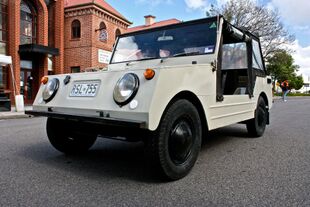Engineering:Buggy (automobile)
From HandWiki
| Buggy | |
|---|---|
 Volkswagen Country Buggy, a military buggy | |
| Overview | |
| Manufacturer | Many |
| Body and chassis | |
| Body style | Lightweight |
| Related | Horse and buggy |
Buggy is generally used to refer to any lightweight automobile with off road capabilities and sparse bodywork. Most are built either as a kit car or from scratch.
History
Originally used to describe very lightweight horse-drawn vehicles for one or two persons,[1] the term was extended to lightweight automobiles as they became popular.[2][3] As automobiles became increasingly sophisticated, the term briefly dropped out of use before being revived to describe more specialised off road vehicles.[4][5][6]
Types

The U.S. Apollo Lunar Roving Vehicle from Apollo 15 on the Moon in 1971
- Bennett buggy, a Canadian, depression era term for an automobile pulled by a horse
- Dune buggy, designed for use on sand dunes
- Baja Bug, a modified Volkswagen Beetle
- Moon buggy, nickname for the Lunar Roving Vehicle used on the Moon during the Apollo program's Apollo 15, Apollo 16, and Apollo 17 missions
- Sandrail, a variant of the dune buggy
- Swamp buggy, designed for use in swamps
- Rock buggy, designed for use in low-speed rock-crawling applications
- Rock bouncer, designed for use in high-speed rock-crawling/bashing or very steep, off-road hillclimb racing, typically tubular steel exoskeleton, 1000hp V8 petrol engine
See also
- American (1902 automobile)
- Buckeye gasoline buggy
- Citroën C-Buggy
- High wheeler
- Kite buggy
- Truggy
- Volkswagen 181
- Volkswagen Country Buggy
References
- ↑ Felton, William (1794–1795). A treatise on carriages. London: printed for and sold by the author; by J. Debrett; R. Fadlder [sic]; J. Egerton; J. White; W. Richardson; and A. Jameson.
- ↑ "Advantages of the automobile buggy". Popular Mechanics. Hearst Magazines. July 1909. p. 72. https://books.google.com/books?id=Ed4DAAAAMBAJ&q=Buggy&pg=RA1-PA72.
- ↑ "untitled". Logansport (Indiana) Daily Reporter: p. 3. 4 December 1901. "He is catapulted through space by the explosion of a ‘gasoline buggy’."
- ↑ "Amphibian 'Marsh buggy' used to hunt oil". Popular Mechanics. Hearst Magazines. April 1937. p. 529. https://books.google.com/books?id=vtoDAAAAMBAJ&q=Buggy&pg=RA1-PA529.
- ↑ "Jungle Buggy packs a load". Popular Science. May 1948. p. 122. https://books.google.com/books?id=aCcDAAAAMBAJ&pg=PA122.
- ↑ Hunn, Max (October 1954). "Swamp-buggy Steeplechase". Popular Mechanics. p. 137. https://books.google.com/books?id=xNwDAAAAMBAJ&pg=PA137.
 |

